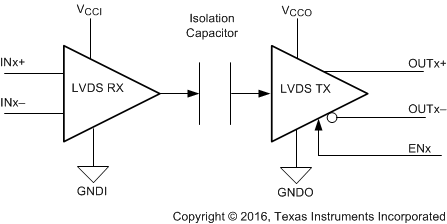-
ISO782xLL High-Performance, 8000-VPK Reinforced Isolated Dual-LVDS Buffer
- 1 Features
- 2 Applications
- 3 Description
- 4 Revision History
- 5 Pin Configuration and Functions
-
6 Specifications
- 6.1 Absolute Maximum Ratings
- 6.2 ESD Ratings
- 6.3 Recommended Operating Conditions
- 6.4 Thermal Information
- 6.5 Power Ratings
- 6.6 Insulation Specifications
- 6.7 Safety-Related Certifications
- 6.8 Safety Limiting Values
- 6.9 DC Electrical Characteristics
- 6.10 DC Supply Current Characteristics
- 6.11 Switching Characteristics
- 6.12 Insulation Characteristics Curves
- 6.13 Typical Characteristics
- 7 Parameter Measurement Information
- 8 Detailed Description
- 9 Application and Implementation
- 10Power Supply Recommendations
- 11Layout
- 12Device and Documentation Support
- 13Mechanical, Packaging, and Orderable Information
- IMPORTANT NOTICE
ISO782xLL High-Performance, 8000-VPK Reinforced Isolated Dual-LVDS Buffer
1 Features
- Complies with TIA/EIA-644-A LVDS Standard
- Signaling Rate: Up to 100 Mbps
- Wide Supply Range: 2.25 V to 5.5 V
- Wide Temperature Range: –55°C to +125°C Ambient
- Low Power Consumption, per Channel at 100 Mbps:
- Typical 9.3-mA (ISO7820LL)
- Typical 9.5-mA (ISO7821LL)
- Low Propagation Delay: 17-ns Typical
- Industry leading CMTI (min): ±100 kV/μs
- Robust Electromagnetic Compatibility (EMC)
- System-Level ESD, EFT, and Surge Immunity
- Low Emissions
- Isolation Barrier Life: > 40 Years
- Wide Body and Extra-Wide Body SOIC-16 Package Options
- Isolation Surge Withstand Voltage 12800 VPK
- Safety-Related Certifications:
- 8000-VPK Reinforced Isolation per DIN V VDE V 0884-10 (VDE V 0884-10):2006-12
- 5700-VRMS Isolation for 1 minute per UL 1577
- CSA Component Acceptance Notice 5A, IEC 60950–1 and IEC 60601–1 End Equipment Standards
- TUV Certification per EN 61010-1 and EN 60950-1
- GB4943.1-2011 CQC Certification
- All Certifications are Planned
2 Applications
- Motor Control
- Test and Measurement
- Industrial Automation
- Medical Equipment
- Communication Systems
3 Description
The ISO782xLL family of devices is a high-performance, isolated dual-LVDS buffer with 8000-VPK isolation voltage. This device provides high electromagnetic immunity and low emissions at low-power consumption, while isolating the LVDS bus signal. Each isolation channel has an LVDS receive and transmit buffer separated by silicon dioxide (SiO2) insulation barrier.
The ISO7820LL device has two forward-direction channels. The ISO7821LL device has one forward and one reverse-direction channel.
Through innovative chip design and layout techniques, the electromagnetic compatibility of the ISO782xLL family of devices has been significantly enhanced to ease system-level ESD, EFT, surge, and emission compliance.
The ISO782xLL family of devices is available in 16-pin SOIC wide-body (DW) package and extra-wide body (DWW) packages.
Device Information(1)
| PART NUMBER | PACKAGE | BODY SIZE (NOM) |
|---|---|---|
| ISO7820LL ISO7821LL |
DW (16) | 10.30 mm × 7.50 mm |
| DWW (16) | 10.30 mm × 14.00 mm |
- For all available packages, see the orderable addendum at the end of the data sheet.
Simplified Schematic

4 Revision History
Changes from * Revision (March 2016) to A Revision
- Changed the device status from Product Preview to Production Data and released full version of the data sheetGo